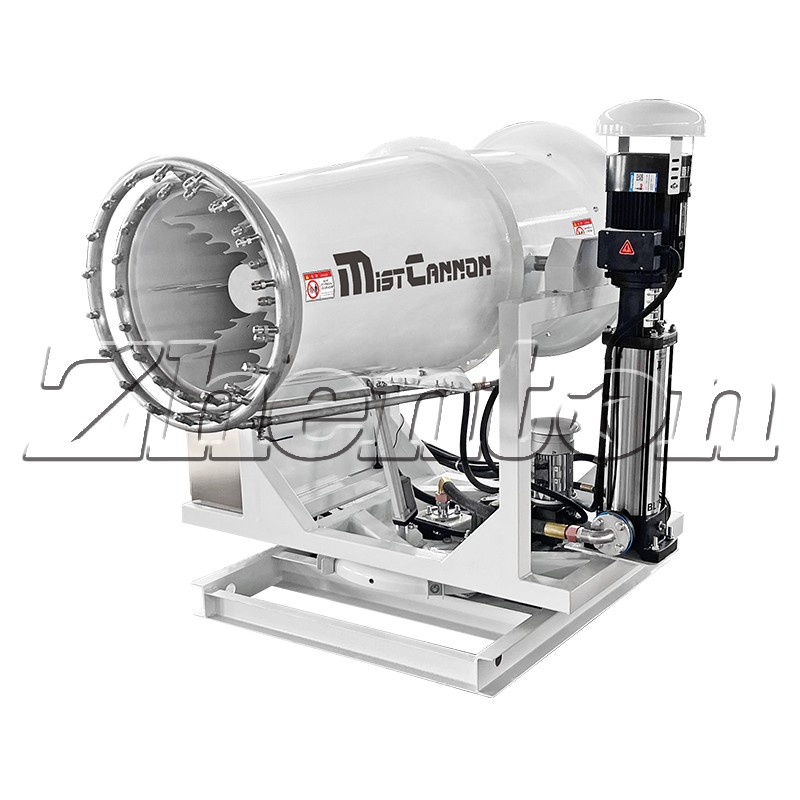
In outdoor adventures, emergency rescues, or field operations, the weather resistance of a tent is directly related to the user’s safety and comfort. However, conventional laboratory tests often fail to replicate extreme natural conditions. The mobile fog cannon, a device commonly used for dust suppression, has become a strict tester of tent weather resistance with its unique “environment-creating” ability.
The core advantage of the mobile fog cannon lies in its powerful atomization and spraying capabilities. It can convert water into fine droplets and, through a fan, precisely control the spraying angle and range, quickly creating a high-humidity and strong-wind simulated environment in a closed space. When testing the rainproof performance of a tent, set the spraying mode of the mobile fog cannon to the “heavy rain gear”. The fog volume of 80 cubic meters per hour combined with a simulated wind speed of level 3 can make the tent surface withstand continuous washing equivalent to moderate to heavy rain within 2 hours. If testing the wind resistance, adjust the fan power to the strong gear. The simulated wind force of level 7, carrying droplets, continuously impacts the connection between the tent fabric and the brackets, which is equivalent to the scenario of continuous strong wind in the wild.
When an outdoor equipment brand was developing a new type of alpine adventure tent, it encountered a tricky problem. Laboratory tests showed that the waterproof index of the fabric met the standard, but the first batch of outdoor trial products had water seepage at the seams in the rain and snow weather on the Western Sichuan Plateau. The team realized that conventional tests lacked the simulation of the “synergistic effect of wind and rain”, so they introduced a mobile fog cannon to build a special test scenario.
In the test, the mobile fog cannon first simulated the common alpine environment of wind and snow with a level 4 wind force and medium fog volume, continuously spraying for 8 hours. Under the alternating effect of repeated wetting and low temperature (controlled by an environmental chamber), tiny bubbles began to appear in the adhesive at the seams of the tent fabric. Then, the team adjusted the mobile fog cannon to the level 6 strong wind mode, directionally impacting the corner of the windward side of the tent – this is where water seepage frequently occurred in the trial products. After 2 hours, the unimproved tent had obvious water seepage points at the seams under the dual pressure of simulated strong wind and water mist.
Based on the weak links identified by the mobile fog cannon test, the R & D team redesigned the seam adhesive process, selected low-temperature resistant environmental protection adhesives, and added protective gaskets at the connection points between the brackets and the fabric. The improved tent was tested again by the mobile fog cannon. In an environment of -10℃, after withstanding 9 hours of simulated level 5 wind and snow impact, there was no water seepage at the fabric and seams, and the brackets did not deform. After this tent was launched, it performed stably in many alpine adventures and became a star product of the brand.

The severe environment simulated by the mobile fog cannon can also expose potential problems of the tent in long-term use. For example, when testing the breathability of the tent, use the mobile fog cannon to create a high-humidity environment inside the tent, and at the same time, spray continuously with low wind speed outside to observe the water vapor exchange efficiency of the fabric – this is directly related to whether condensation water accumulates in the tent in hot weather. A rescue tent brand once found through this method that the side window breathable net of a certain tent was prone to absorb water vapor and block the mesh in a high-humidity environment, and then optimized the mesh material.
For special types of tents such as military tents and disaster relief tents, the testing role of the mobile fog cannon is even more critical. When simulating the high-humidity environment in flood-hit areas, the mobile fog cannon, combined with a salt spray generator (to simulate water quality corrosion), can quickly test the mildew resistance of the tent fabric and the rust resistance of metal parts. A disaster relief tent manufacturer improved the mildew resistance level of the tent from level 0 to level 1 through the mobile fog cannon test, ensuring that it can be used safely for more than 30 days in the humid environment after a disaster.
The weather resistance of a tent is not just cold data in the laboratory, but a reliable guard in the wild environment. With its precise and controllable environment simulation ability, the mobile fog cannon allows the tent to undergo a “concentrated version” of natural tests before leaving the factory. Every detail, from the fabric and seams to the brackets, is repeatedly verified in harsh simulated scenarios.

This testing method not only helps brands improve product quality but also gives users more peace of mind in the outdoor environment. When you pitch a tent in a heavy rain or set up a temporary shelter in a strong wind, those tents “tempered” by the mobile fog cannon are silently using their reliable weather resistance to isolate you from the wind and rain outside – this is the temperature and power that technology endows outdoor equipment with.
Contact With Us
If you have any questions please fell free to contact with us.